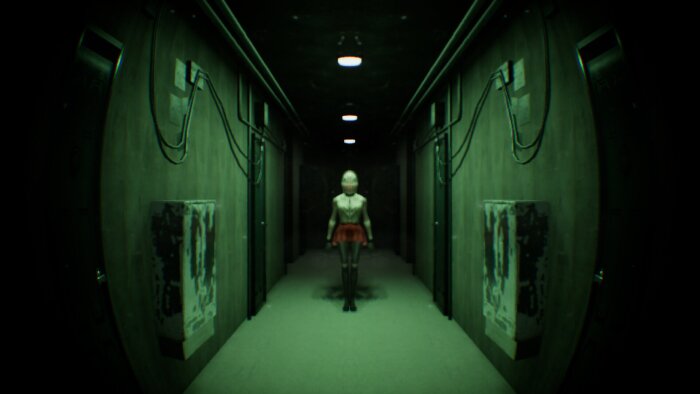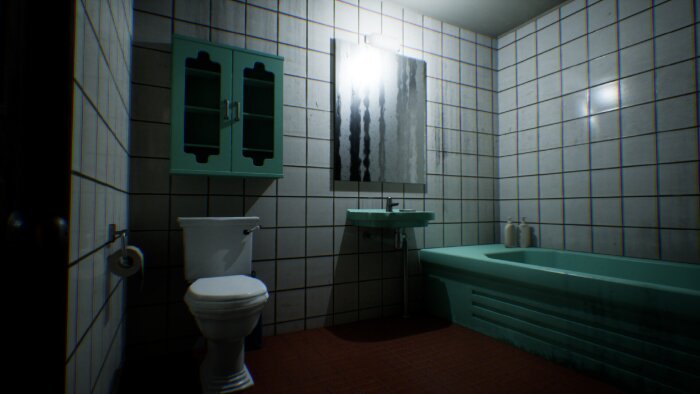Who's at the door? Game Details
Title: Who's at the door?
Genre: Adventure, Indie, Simulation
Developer: SKONEC Entertainment
Publisher: SKONEC Entertainment
Release Date: 18 July 2025
Store: Steam
Game Releasers: P2P
About Who's at the door? Game
Trapped in a psychotic nightmare, can you discern reality from hallucination in "Who's at the Door?" to take your meds in time or face the consequences?

"Who's at the Door?" presents a chilling descent into the fractured mind of a psychiatric patient grappling with relentless hallucinations and profound memory loss. Players are thrust into the claustrophobic confines of a small house, a psychological battleground where the boundaries between reality and delusion blur with each passing moment. The core gameplay mechanic revolves around discerning the true nature of visitors who arrive at the protagonist's door, a task complicated by the ever-present specter of hallucinatory episodes.
Navigating this treacherous mental landscape requires meticulous observation. Players must scrutinize their surroundings, searching for subtle cues that might distinguish genuine perceptions from the deceptive illusions conjured by their psychosis. The success of the protagonist's treatment hinges on the player's ability to make the right decision: to open the door and accept medication from a visitor deemed real, or to administer the medication independently when trapped within the throes of a hallucination.
The gameplay structure is built around an eight-day cycle, during which the player must adhere to this crucial routine. Each day presents a fresh set of challenges and escalating psychological torment as the protagonist's condition threatens to unravel. As the days progress, the player must carefully monitor the persistence of hallucinations. If these illusions dissipate, it signals a moment of clarity, a safe opportunity to interact with the outside world and receive treatment. However, if the hallucinations linger, clinging to the protagonist's perception, it indicates a continued distortion of reality, necessitating self-administration of the medication.

The game's narrative is fragmented and unsettling; players are given limited information about the protagonist's past or the nature of their illness. This deliberate ambiguity contributes to the overall sense of unease and disorientation, mirroring the protagonist's own confusion and mental fragmentation. The player is forced to piece together the narrative through environmental details, subtle clues, and the shifting nature of their own perceptions.
"Who's at the Door?" offers a branching narrative with multiple endings, encouraging players to delve deeper into the protagonist's psyche and uncover the hidden truths buried beneath layers of delusion. Scattered throughout the game are hidden doll pieces, each one serving as a key to unlock a more complete understanding of the protagonist's past and the underlying causes of their mental state. Collecting these fragments rewards players with access to alternate narratives and ultimately leads to the true final ending, which promises to unravel the mysteries that have plagued the protagonist's existence.
The game's psychological horror elements are amplified by its immersive sound design and disturbing visuals. The unsettling atmosphere is crafted through a combination of ambient noises, distorted soundscapes, and unsettling imagery that reflects the protagonist's fractured mental state. The game employs a minimalist approach to storytelling, relying on visual and auditory cues to convey the protagonist's emotional turmoil and the ever-present threat of their hallucinations.

"Who's at the Door?" draws inspiration from surreal and psychological horror titles that prioritize atmosphere and psychological exploration over jump scares and traditional horror tropes. The game aims to create a sense of unease and disorientation, immersing players in the protagonist's subjective experience of psychosis. The game's short playtime, estimated at around 90–120 minutes, ensures a focused and intense experience, delivering a compact yet impactful exploration of mental illness and the struggle to maintain a grip on reality.
The game's creators, SKONEC Entertainment, have issued a content warning, acknowledging that "Who's at the Door?" contains themes and visuals that may not be suitable for all audiences. The game features depictions of violence, graphic blood, psychological distress, and disturbing imagery, reflecting the harsh realities of mental illness and the protagonist's internal struggles. This warning serves as a reminder that the game is intended for mature audiences who are prepared to confront challenging and potentially disturbing content. The game is scheduled for release on July 18, 2025.
The success of "Who's at the Door?" relies heavily on its ability to create a believable and immersive portrayal of mental illness. The game's mechanics, narrative, and visual design must work together to convey the protagonist's confusion, fear, and isolation. Players must feel a genuine sense of empathy for the protagonist and a growing sense of dread as they navigate the treacherous landscape of their mind. The game's exploration of hallucinations, memory loss, and the struggle to distinguish reality from delusion must be handled with sensitivity and respect, avoiding harmful stereotypes or sensationalized portrayals of mental illness.

One of the key challenges in developing "Who's at the Door?" is creating a gameplay loop that is both engaging and psychologically compelling. The core mechanic of observing the environment and deciding whether to open the door or self-administer medication must be more than just a simple binary choice. The game must introduce subtle variations and escalating challenges to keep players engaged and to accurately reflect the unpredictable nature of mental illness. The hallucinations themselves must be varied and believable, blurring the lines between reality and delusion and forcing players to constantly question their own perceptions.
The game's multiple endings and hidden doll pieces add an element of replayability and encourage players to fully explore the protagonist's psyche. Each playthrough offers a new opportunity to uncover hidden details and to piece together the fragmented narrative. The true final ending promises to reveal the underlying causes of the protagonist's mental illness and to provide a sense of closure to their story. However, it is important that this ending is earned through genuine effort and exploration, rather than simply being handed to the player. The process of collecting the doll pieces and unlocking the true ending should be a rewarding and meaningful experience, reflecting the protagonist's own journey towards self-discovery and healing.
"Who's at the Door?" has the potential to be more than just a horror game; it could be a powerful and thought-provoking exploration of mental illness. By immersing players in the protagonist's subjective experience, the game can foster empathy and understanding towards those who struggle with mental health challenges. However, it is crucial that the game is developed with sensitivity and respect, avoiding harmful stereotypes and ensuring that the portrayal of mental illness is both accurate and responsible. If done right, "Who's at the Door?" could be a valuable contribution to the conversation surrounding mental health awareness and a testament to the power of video games to explore complex and challenging themes.

Who's at the door? Key Features
- * Dive into a mind-bending psychological horror where reality and hallucination blur!
- * Survive 8 days battling psychosis and unlock various endings!
- * Unravel a dark narrative inspired by surreal classics like The Exit 8!
- * Collect hidden doll pieces to unlock the shocking true final ending!
- * Experience roughly 90–120+ minutes of gripping gameplay!
- * Face mature and disturbing themes: violence, blood, and psychological distress!
Who's at the door? Gameplay
Download Links for Who's at the door?
Download Whos.at.the.door.v1.0.9-P2P
Mega
Whos.at.the.door.v1.0.9-P2P.rar
1fichier
Whos.at.the.door.v1.0.9-P2P.rar
Pixeldrain
Whos.at.the.door.v1.0.9-P2P.rar
Mediafire
Whos.at.the.door.v1.0.9-P2P.rar
Gofile
Whos.at.the.door.v1.0.9-P2P.rar
Ranoz
Whos.at.the.door.v1.0.9-P2P.rar
Datanodes
Whos.at.the.door.v1.0.9-P2P.rar
Filemirage
Whos.at.the.door.v1.0.9-P2P.rar
Drop
Whos.at.the.door.v1.0.9-P2P.rar
Bowfile
Whos.at.the.door.v1.0.9-P2P.rar
Send.cm
Whos.at.the.door.v1.0.9-P2P.rar
Buzzheavier
Whos.at.the.door.v1.0.9-P2P.rar
Frdl
Whos.at.the.door.v1.0.9-P2P.rar
Wdfiles
Whos.at.the.door.v1.0.9-P2P.rar
Files dp
Whos.at.the.door.v1.0.9-P2P.rar
Mxdrop
Whos.at.the.door.v1.0.9-P2P.rar
Chomikuj
Whos.at.the.door.v1.0.9-P2P.rar
Vikingfile
Whos.at.the.door.v1.0.9-P2P.rar
Down mdiaload
Whos.at.the.door.v1.0.9-P2P.rar
Hexload
Whos.at.the.door.v1.0.9-P2P.rar
1cloudfile
Whos.at.the.door.v1.0.9-P2P.rar
Usersdrive
Whos.at.the.door.v1.0.9-P2P.rar
Filefactory
Whos.at.the.door.v1.0.9-P2P.rar
Megaup
Whos.at.the.door.v1.0.9-P2P.rar
Clicknupload
Whos.at.the.door.v1.0.9-P2P.rar
Dailyuploads
Whos.at.the.door.v1.0.9-P2P.rar
Depositfiles
Whos.at.the.door.v1.0.9-P2P.rar
Ddownload
Whos.at.the.door.v1.0.9-P2P.rar
Rapidgator
Whos.at.the.door.v1.0.9-P2P.rar
Nitroflare
Whos.at.the.door.v1.0.9-P2P.rar
Turbobit
Whos.at.the.door.v1.0.9-P2P.rar
System Requirements for Who's at the door?
To successfully play "Who's at the door?", your PC needs to meet specific requirements. For minimum playability, you'll need a 64-bit Windows 10 operating system, an Intel i5 or AMD Ryzen 5 processor from approximately 2016 or newer, 4 GB of RAM, a DirectX 11 compatible AMD or NVIDIA graphics card with at least 1 GB of VRAM, DirectX version 11, and 2 GB of available storage space. For the best experience, the recommended specifications include a 64-bit Windows 10 or 11 operating system, an Intel i5 or AMD Ryzen 7 processor from around 2018 or later, 8 MB of RAM, a DirectX 12 compatible AMD or NVIDIA graphics card with at least 4 GB of VRAM, DirectX version 12, and still 2 GB of available storage space.
Minimum:- OS: Windows 10 64-bit
- Processor: Intel i5 or AMD Ryzen 5 from around 2016 or later
- Memory: 4 GB RAM
- Graphics: DirectX 11 Feature Level AMD or NVIDIA Card with 1 GB VRAM
- DirectX: Version 11
- Storage: 2 GB available space
- OS: Windows 10 / 11 (64-bit)
- Processor: Intel i5 or AMD Ryzen 7 from around 2018 or later
- Memory: 8 MB RAM
- Graphics: DirectX 12 Feature Level AMD or NVIDIA Card with 4 GB VRAM
- DirectX: Version 12
- Storage: 2 GB available space
How to Download Who's at the door? PC Game
1. Extract Release
2. Launch The Game
3. Play!

























